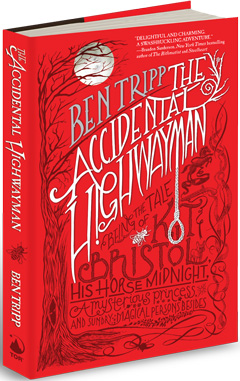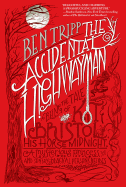The Accidental Highwayman
by Ben Tripp
Ben Tripp's funny, wise and suspenseful first novel for young people, The Accidental Highwayman, takes readers through the perilous paths of 18th-century stagecoaches, riddled with bandits and populated by faeries.
Tripp admits in an opening "Editor's Note" to discovering the jottings of Kit Bristol, the tale's narrator, in an old sea chest that belonged to one of his ancestors, unopened for 150 years. Kit--whose full name is Christopher Bristol--recounts his youthful adventures with the benefit of hindsight. As an orphan taken in by Master James Rattle, Kit discovers that his master doubles as the notorious highwayman Whistling Jack. But there's nothing accidental about him. No, the title refers to then 16-year-old Kit, who rides to get help for his injured master on the man's majestic black horse, Midnight, and is mistaken for Whistling Jack. Unable to save Master Rattle, Kit receives from the man a legacy: a strange map that he can't make sense of, his French bulldog, Demon, and, of course, his horse, Midnight.
Along the way, Tripp explains the odd workings of the British aristocracy. James Rattle, as the third son of a wealthy and influential lord, nonetheless had no claim to his father's estate, and therefore resorted to this strange vocation (robbing the rich by night). Kit finds himself pulled into that life out of necessity--his horse and boots are identifiable as his master's and he has no other means of income.
His master's dying wish is for Kit to travel to the deepest part of Kingsmire Forest, to an old witch who'll keep Rattle's beloved French bulldog safe while Kit goes on a quest of the woman's making--a mission left incomplete by his master. Along the way, Kit has many adventures, the first of which is an encounter with the Princess Morgana, daughter of a human mother and the Faerie King, who has promised her to King George III. Kit, who never knew Faeries existed, accepts the help of Faeries Willum and Gruntle in order to free Princess Morgana. Alas, she lets him know in no uncertain terms that she has no further need of him. She is proven wrong. (A wonderful, humorous scene depicts Kit rescuing the royal from certain death in a bull's pen.)
Kit had a previous life as a trick-rider in a circus. His skills on horseback are what first attracted Master Rattle, and they serve the teen well now. Kit's path becomes entangled with one of his friends from that era, Lily the high-rope dancer. Her Uncle Cornelius has an "extraordinary conveyance" that they use as a "cover" to further their mission, sneaking into towns and eluding the Goblings of the Faery world. Fred the baboon also joins up from their former circus life.
The author combines all the elements of farce, yet achieves a highbrow blend of literary mystery, buoyed by clever use of language and Old-World 18th-century English locution. At one point Kit says, "Forgive my pride: Respectability is like wine. It goes straight to the head of one who hasn't had it before." The hero gets pulled into a world of Faeries he never knew (or believed) existed, and receives lessons from Willum and Gruntle on the pecking order within the world of magic, and on the Eldritch Law, a code of ethics that guides the magical creatures.
Tripp's deliciously drawn villains include Captain Sterne, who hates Whistling Jack because his fiancée fell in love with the brigand, and who's obsessed with capturing him, and a one-eyed pirate duchess, whose soul was captured by the Faerie King and resorts to true horror tactics in an attempt to capture the Princess Morgana. And at times the Princess Morgana is her own worst enemy.
How Kit deals with these situations shows readers his true nature--kindness and integrity prevail. He is an orphan with no special talents (save for trick-riding), yet in each situation, he does the right thing. His constant questioning of himself (does he really love the princess or is he merely enchanted by her--literally?) endears him to readers. And his sense of humor about his inexperience and naïveté telegraphs his compassion for his less experienced self. His voice comes through as a mix of intelligence and naïveté, wonder and understanding. And his command of language puts readers in mind of a time when words were used more precisely. (Footnotes define archaic words and contraptions; these never intrude, but rather illuminate the goings on. One example is the delectable word "slubberdegullion," which means "all-around wretch, completely without virtue.")
While this novel comes to a rousing, thoroughly resounding close, two more books will star Kit and his further adventures. --Jennifer M. Brown








